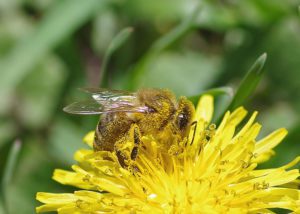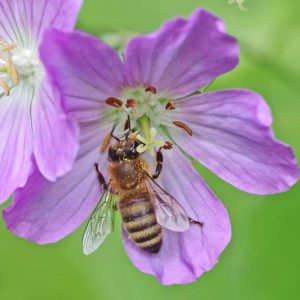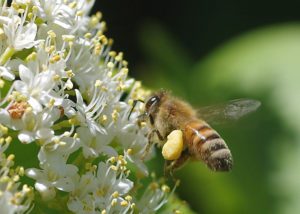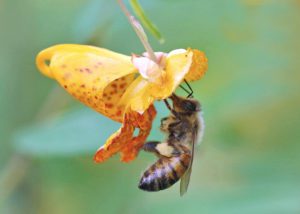Howdy, BugFans,
Somewhere in a remote corner of Southeast Asia, in the neighborhood of 34 million years ago, a small bee originated that would change the course of the world.
Today, we call them honey bees (two words, not one). There are seven species in the genus Apis (family Apidae), and their family tree is complicated. Our common North American honey bee is Apis mellifera, which bugguide.net calls the Western honey bee, a species that includes about 25 subspecies (and lots of hybrids). Western honey bees are Heinz 57s, genetically. Apis mellifera (Apis is Latin for “bee,” and mellifera means “honey-bearing”) probably evolved in eastern Africa/western Asia.
The term “bee” can be a catch-all in the vernacular, covering yellowjackets as well as a bunch of actual bees. Honey bees (workers – the most-often seen) have in common hairy eyes, a hairy thorax and a less-hairy abdomen, pollen baskets, distinctive venation in the front wingtip, and a barbed stinger (more about that in a sec). Workers have a number of (temporary) super powers, including brood-feeding glands on their heads, glands in the abdomen that produce wax, which oozes through the pores and is chewed and formed into honeycomb and brood cells, and two stomachs – one solely for nectar storage.
Fossil evidence suggests that honeybees got to North America millions of years before the First People did, but then they died out. They reentered the continent with the European settlers in 1622 (natives called them “white man’s flies”), prized for their honey and wax production, an introduced pollinator of introduced agricultural crops.
Most insects lead solitary lives, but honey bees are eusocial, living in a highly organized society marked by the presence of multiple generations under one roof, brood care, the division of labor, and the loss, by individuals of one caste, of the ability to do something that another caste can do.
Some highlights of a bee’s biography:
- Queens have a nuptial flight into a cloud of drones away from her home hive, during which she mates several times, but only on that occasion. She is the mother of the hive, able to lay 1,000 eggs a day during her life (two to five years) and as many as 200,000 eggs in total.
- She intentionally fertilizes her eggs – or she doesn’t. Unfertilized eggs become males/drones; fertilized eggs will be workers or queens, depending on what they are fed in the larval cell.
- Worker bees rotate through a variety of tasks during their brief (about six week) lives (age polyethism). They start as nurse bees, and when they can’t produce royal jelly any more, they build comb, then receive nectar and pollen from foraging bees, then guard the hive, then become foragers themselves. Some are even undertakers.
- Honey bee senses are acute. They see in color and can perceive UV light, which bounces off flowers in ways we cannot discern, and polarized light, which helps them navigate. They communicate with and detect vibrations, and one source said that they can hear the vibrations of the waggle dances that foragers use to direct their sisters to flowers. Each hive has its own chemical aura, and its scent/taste allows them to distinguish invaders from hive-mates.
- Pheromones relay messages from the queen to the hive and among bees within the hive, and when an intruder breaches the hive, pheromone signals from the sentinels mobilize a defense (honey bees may chase an intruder for hundreds of feet). Pheromones even play a part in that unique stinger. Because of its multiple barbs, a honey bee’s stinger stays in the sting-ee, ripping out of the bee’s abdomen and causing its death. The stinger continues to pulse after detachment, injecting more venom, and an adjacent gland continues to pump out alarm pheromones at the sting site, inviting a crowd (allergies aside, said one reference, “it takes about 20 stings per kilogram of body weight to be life threatening”).
- As the inhabitants of the royal cells mature, the older queen will vacate the hive in a swarm, accompanied by as many as half the hive’s workers, looking for a hospitable place to begin a new life. Back at the hive, the virgin queen who emerges from her egg first has the advantage. While there may be a secondary exit – an afterswarm – it’s more likely that she will execute her royal sisters in their cells or fight/sting them to death.
- What happens in winter? Honey bees are somewhat endothermic (“warm-blooded”) – they can warm their bodies by quivering their flight muscles. Workers crowd around the queen in a “winter cluster” at the center of the hive, shivering to keep the core temperature at about 80 degrees, rotating in from the edges so that no-one gets too chilly, fueled by the honey they’ve stored. Drones are considered non-essential to the hive in winter and are evicted. During the summer, bees may flap their wings to cool the hive.
Honey is not, as a former Wisconsin Governor famously said, “Bee poop.” But it is (technically) bee “vomit” – https://www.huffingtonpost.com/entry/what-is-honey_us_58c6a525e4b0d1078ca80e2c (be sure to watch the “How do bees make honey?” video).
Foraging bees collect carb-rich nectar and protein-rich pollen from flowers. They dance to tell other bees where to find flowers – the round dance indicates nearby food; the waggle dance tells the distance and direction of flowers more than 150 yards away. Watch the video and follow the bouncing blue ball: http://articles.extension.org/pages/26930/dance-language-of-the-honey-bee.
What could possibly go wrong? Along with the usual suspects like mantises, birds, and bears, honey bees are preyed upon by some bee-specific arthropods like comb-destroying moth larvae and bee-destroying parasitic mites. A mite called Varroa destructor, which originated in Asia but didn’t stay there, has lived up to its name with staggering results, killing whole colonies. Honey bees are also susceptible to a variety of viruses, bacteria, fungi, and protozoans that kill them outright or weaken them, setting them up for other afflictions. Bee-keepers treat their hives and bees, but wild honey bee colonies in North America have been hit very hard by Varroa mites.
Enter Colony Collapse Disorder (CCD), a mysterious phenomenon that causes colonies to fail when most of their workers simply disappear, leaving behind an insufficient number of bees to run the hive (and no dead bodies for scientists to analyze). CCD has been around under a variety of names for 100 years and more, but huge die-offs in America and Europe in the early 2000’s put it on the radar. Ten years ago, between 30% and 75% of North American hives experienced significant die-offs.
Fingers have been pointed at Varroa mites, some new bee microbe, herbicides/pesticides, environmental stresses/climate change, malnutrition, and immune issues, but there has been no agreement, other than that CCD could be a syndrome in which a number of low-level antagonists turn lethal when combined. A group of pesticides called neonicotinoids seems to make bees more susceptible to CCD.
Several reports said that CCD has been letting up a bit in the past few years. The incidence of CCD in hives seems to have dropped from 60% a decade ago to about 33% now (remember – we counting domesticated hives). Bumblebees, also vital pollinators, do not get CCD but their populations are threatened, too (http://uwm.edu/field-station/celebrating-bumblebees/).
KILLER BEES!! Various species and subspecies of honey bees have different talents and environmental tolerances. The infamous “Africanized honey bee” (Apis mellifera scutellata) was developed in the 1950’s by cross-breeding several subspecies of Apis mellifera with the intent of boosting honey production, and it was brought to Brazil in 1950 for a trial run (it escaped, of course). The African bee turned out to be well-suited to the tropics; it’s a great forager, more nomadic than some other subspecies, and more disease-resistant, but it’s less cold-tolerant, and it turns out that tropical honey bees don’t store as much honey in combs because they’re surrounded by food 24/7. African bees are much more aggressive in defense of their hive than their more docile cousins, and no matter how diluted the gene pool becomes with interbreeding, its aggressive proclivities remain. Inevitably, they’re heading north (the BugLady loves animated maps – https://en.wikipedia.org/wiki/Africanized_bee#/media/File:Killerbees_ani.gif).
Have you thanked a honey bee today? Only two species of Apis have been put to work for us (the ancient Egyptians cultivated them), but they’re the busiest bees on the planet, providing pollination services to crops worth about $200 billion a year globally. According to the USDA Natural Resources Conservation Service, “one out of every three bites of food in the United States depends on honey bees and other pollinators.” Besides their honey (someone once did the math and figured out that a quart of honey represents 48,000 frequent flyer miles for bees!), we also harvest their wax and royal jelly, and bee venom may be an effective medicine for auto-immune diseases (the BugLady knew someone who allowed himself to be stung by honeybees every few weeks – there’s some evidence that the histamine reaction is beneficial for arthritis).
How can we help bees? Plant flowers, support pollination highways, put out pans of water or create bee-friendly spots in bird baths, and use chemicals specifically and with caution, in the morning before pollinators appear, if at all.
Kate Redmond, The BugLady
http://uwm.edu/field-station/




